40 terminal velocity free body diagram
5.7 Drawing Free-Body Diagrams - University Physics Volume ... Figure 5.32 (a) The free-body diagram for isolated object A. (b) The free-body diagram for isolated object B. Comparing the two drawings, we see that friction acts in the opposite direction in the two figures. Because object A experiences a force that tends to pull it to the right, friction must act to the left. Because object B experiences a component of its weight that pulls it to the … PDF Worksheet #1 Free Body or Force diagrams… Worksheet #1 Free Body or Force diagrams… Drawing Free-Body Diagrams . Free-body diagrams are diagrams used to show the relative magnitude and direction of all forces acting upon an object in a given situation. A free -body diagram is a special example of the vector diagrams; these diagrams will be used throughout your study of physics.
PDF Fluid Mechanics: Stokes' Law and Viscosity velocity of the sphere relative to the fluid, and d is the diameter of the sphere. Using this equation, along with other well-known principle of physics, we can write an expression that describes the rate at which the sphere falls through a quiescent, viscous fluid. To be begin we must draw a free body diagram (FBD) of the sphere. That is we must

Terminal velocity free body diagram
PPT PowerPoint Presentation She has reached TERMINAL VELOCITY (air resistance =gravity) :acceleration and force Physics 12/16/04 * In order to understand this motion, we need to use a free body diagram 12/16/04 * Terminal Velocity of a human~180mph 12/16/04 :acceleration and force Physics 12/16/04 * In order to understand this motion, we need to use a free body diagram 12 ... Terminal Velocity - NASA The constant vertical velocity is called the terminal velocity . Using algebra, we can determine the value of the terminal velocity. At terminal velocity: D = W Cd * r * V ^2 * A / 2 = W Solving for the vertical velocity V, we obtain the equation V = sqrt ( (2 * W) / (Cd * r * A) where sqrt denotes the square root function. PDF Dynamics of a Skydiver obtaining its orthogonal components from each velocity component. Figure 1 shows the free body diagram of the idealized skydiver a few seconds after leaving the airplane. The system of coordinates chosen associates the x direction with the horizontal and y direction with the vertical.
Terminal velocity free body diagram. Velocity - Wikipedia The velocity of an object is the rate of change of its position with respect to a frame of reference, and is a function of time. Velocity is equivalent to a specification of an object's speed and direction of motion (e.g. 60 km/h to the north). Velocity is a fundamental concept in kinematics, the branch of classical mechanics that describes the motion of bodies. Velocity is a physical … Identifying Free-Body Diagrams for Systems in Equilibrium ... A skydiver jumps out of a chopper and after a while, attains the terminal velocity. Draw a free-body diagram of the skydiver. answer choices. Answers: Velocity - definition of velocity by The Free Dictionary ve·loc·i·ty (və-lŏs′ĭ-tē) n. pl. ve·loc·i·ties 1. Rapidity or speed of motion; swiftness. 2. Physics A vector quantity whose magnitude is a body's speed and whose direction is the body's direction of motion. 3. a. The rate of speed of action or occurrence. b. The rate at which money changes hands in an economy. [Middle English velocite, from ... Physics Of Skydiving - Real World Physics Problems The figure below shows a free-body diagram of this. Where: g is the acceleration due to gravity, which is 9.8 m/s 2 m is his mass D is the drag force acting upwards W is the force of gravity pulling him down v is the speed at which he falls vt is the constant (terminal) speed he reaches when D = W
Terminal velocity - Wikipedia Based on wind resistance, for example, the terminal speed of a skydiver in a belly-to-earth (i.e., face down) free fall position is about 195 km/h (120 mph; 54 m/s). This speed is the asymptotic limiting value of the speed, and the forces acting on the body balance each other more and more closely as the terminal speed is approached. In this example, a speed of 50% of terminal speed is reached ... Terminal Velocity - IIT JEE Study Material For Mains and ... Terminal Velocity is the highest velocity that is achieved by an object as it falls through a fluid or a gas. Terminal force occurs when an object is subjected to a resistance that increases with the increase in velocity and when its resistance equals the driving force. An object that is moving downwards with a higher speed compared to terminal velocity will eventually slow down with the ... 5.7 Drawing Free-Body Diagrams – University Physics Volume 1 Figure 5.32 (a) The free-body diagram for isolated object A. (b) The free-body diagram for isolated object B. Comparing the two drawings, we see that friction acts in the opposite direction in the two figures. Because object A experiences a force that tends to pull it to the right, friction must act to the left. Because object B experiences a component of its weight that pulls it to the … PhysicsLAB: Freebody Diagrams #2 Refer to the following information for the next four questions. True or False: The magnitude of the normal, , is smaller than the object's weight. True. False. A 5 kg mass is being pushed across a rough table at a constant velocity by a constant force, F = 15 N, which acts at an angle θ = 37º to the horizontal.
A ball is falling at terminal velocity. Terminal velocity ... Which free body diagram shows the ball falling at terminal velocity? A free body diagram with one force pointing downward labeled F Subscript g Baseline 20 N. A free body diagram with 2 forces: the first pointing downward labeled F Subscript g Baseline 20 N and the second pointing upward labeled F Subscript air Baseline 20 N. Solved Draw a free body diagram for a skydiver who just ... Physics questions and answers. Draw a free body diagram for a skydiver who just jumped out of a plane, for a skydiver falling at terminal velocity before opening her parachute, for a skydiver moments after her parachute fully opens, and for a skydiver falling at a nice slow terminal velocity with her parachute open. Speed of a Skydiver (Terminal Velocity) - The Physics Factbook "The terminal velocity of a falling human being with arms and legs outstretched is about 120 miles per hour (192 km per hour) — slower than a lead balloon, but a good deal faster than a feather!" 53 m/s: The terminal velocity of a falling body occurs during free fall when a falling body experiences zero acceleration. This is because of the ... Newton's Laws Review - with Answers #3 - Physics Classroom 39. A 2-kg box is free-falling from the table to the ground. ("Free-falling" indicates that the only force that influences the motion is the force of gravity.) 40. A 2-kg box equipped with a parachute is falling at a terminal velocity after being dropped from a plane. (A "terminal velocity" indicates a constant velocity and a balance of forces.)
5.7 Drawing Free-Body Diagrams – General Physics Using ... Figure 5.32 (a) The free-body diagram for isolated object A. (b) The free-body diagram for isolated object B. Comparing the two drawings, we see that friction acts in the opposite direction in the two figures. Because object A experiences a force that tends to pull it to the right, friction must act to the left. Because object B experiences a component of its weight that pulls it to the left ...
[Expert Answer] A ball is falling at terminal velocity ... Terminal velocity occurs when the ball is in equilibrium and the forces are balanced. Which free body diagram shows the ball falling at terminal velocity? A free body diagram with one force pointing downward labeled F Subscript g Baseline 20 N.
Terminal Velocity, Equations, Free Fall, Drag Force - Fact ... Terminal Velocity =V = [ (2 * W) / (K*r*A)] 1/2[formula for Terminal Velocity] here K = Drag Coefficient of the falling object (it depends on the inclination of the shape and some other criteria like airflow) r = air density. W = weight of the falling object. A = cross sectional area of the object falling.
6.4 Drag Force and Terminal Speed - University Physics ... The free-body diagram of this object with the positive direction downward is shown in Figure 6.33. Newton’s second law in the vertical direction gives the differential equation . m g − b v = m d v d t, m g − b v = m d v d t, where we have written the acceleration as d v / d t. d v / d t. As v increases, the frictional force –bv increases until it matches mg. At this point, there is no ...
PDF Free-Body Diagrams - Ms. Poulton's Science & Math Class ... Construct free-body diagrams for the following physical situations. Label all forces (e.g, Fgrav, Fnorm, Fapp, Ffrict, Fair, Ftens, etc. ). a. A physics book rests upon a level table. b. A skydiver is falling and has reached a terminal velocity. c. A large crate is being pushed leftward at a constant velocity. d. A sledder has reached
Which free body diagram shows the ball falling at terminal ... Answer: 1 📌📌📌 question A ball is falling at terminal velocity. Terminal velocity occurs when the ball is in equilibrium and the forces are balanced. Which free body diagram shows the ball falling at terminal velocity? - the answers to estudyassistant.com
Physical Model for Terminal Velocity – Body Physics: Motion ... Free body diagrams of a person with 90 kg mass during a skydive. The initial speed is zero, so drag force is zero. As speed increases, the drag force grows, eventually cancelling out the person's weight. At that point acceleration is zero and terminal velocity is reached. Dynamic Equilibrium With a net force of zero the skydiver must be in
PDF Project 3: Mission to Mars - Edutopia approaching terminal velocity. Students will be able to draw free-body diagrams for objects falling in the presence of air objects approaching terminal velocity, and objects falling at terminal velocity. Students will be able to draw free-body diagrams depicting that a greater force of air resistance is required to balance out the greater
Drawing Free-Body Diagrams - Physics Classroom Drawing Free-Body Diagrams. Free-body diagrams are diagrams used to show the relative magnitude and direction of all forces acting upon an object in a given situation. A free-body diagram is a special example of the vector diagrams that were discussed in an earlier unit. These diagrams will be used throughout our study of physics.
Terminal Velocity Derivation With Simple Step By Step ... - BYJUS v t is the terminal velocity, m is the mass of the falling object, g is the acceleration due to gravity, C d is the drag coefficient, 𝜌 density of the fluid through which the object is falling, and A is the area projected by the object. Terminal Velocity Derivation. Deriving terminal velocity using mathematical terms according to the drag ...
6.4 Drag Force and Terminal Speed - University Physics ... The terminal velocity is the same as the limiting velocity, which is the velocity of the falling object after a (relatively) long time has passed. Similarly, the limiting distance of the boat is the distance the boat will travel after a long amount of time has passed. ... Draw a free-body diagram of the forces to see what the angle . should be.)
PDF Experiment 6: Viscosity (Stoke's Law) - GitHub Pages net downward force and acceleration become zero and the velocity becomes constant. This is known as the terminal velocity vT. Therefore, by de nition, when the terminal velocity is achieved the net force on the sphere is zero, the three forces balance each other out. Looking at the free-body diagram this means W= FB + FD (2) Substituting (1)
Constant Velocity: Definition, Equation & Examples - Video ... 16.09.2021 · Velocity may also be represented in a diagram as an arrow like the one illustrated in the figure below. The magnitude of the vector is the length of …
Terminal velocity - Forces, acceleration and Newton's laws ... Terminal velocity. Near the surface of the Earth, any object falling freely will have an acceleration of about 9.8 metres per second squared (m/s 2).Objects falling through a fluid. eventually ...
PDF Drawing and Interpreting Free-Body Diagrams Drawing and Interpreting Free-Body Diagrams 37. Construct free-body diagrams for the following physical situations at the instant in time for which they are described. As is always done in free-body diagrams, label the forces according to type and ... terminal velocity. l. After reaching a terminal velocity, a falling skydiver has opened her ...
8.6 Drag Forces in Fluids - MIT OpenCourseWare The free body diagram is shown in the Figure 8.32(b). Newton’s Second Law is then . dv mg . − 6πη. Rv = m , (8.6.3) dt . 8-3. v ln t t where . v . is the . y -component of the velocity of the marble. Let γ = 6πη. R / m ; the SI units γ are [s. −1]. Then Eq. (8.6.3) becomes . dv g . −γ. v = , (8.6.4) dt . Suppose the object has an initial . y -component of velocity . v (t = 0 ...
Terminal Velocity and Free Fall - ThoughtCo Terminal velocity and free fall are two related concepts that tend to get confusing because they depend on whether or not a body is in empty space or in a fluid (e.g., an atmosphere or even water). Take a look at the definitions and equations of the terms, how they are related, and how fast a body falls in free fall or at terminal velocity under different conditions.
Free Body Diagrams - people.springfield.k12.or.us Draw a free body diagram of a meteor that is falling towards earth at terminal velocity. F air F gravity Net Force = 0 N The meteor is falling down, but its net force is 0 N! There is no acceleration!
Free Fall and Air Resistance - Physics Classroom The free-body diagrams are shown below for the instant in time in which they have reached terminal velocity. As learned above , the amount of air resistance depends upon the speed of the object. A falling object will continue to accelerate to higher speeds until they encounter an amount of air resistance that is equal to their weight.
PDF Dynamics of a Skydiver obtaining its orthogonal components from each velocity component. Figure 1 shows the free body diagram of the idealized skydiver a few seconds after leaving the airplane. The system of coordinates chosen associates the x direction with the horizontal and y direction with the vertical.
Terminal Velocity - NASA The constant vertical velocity is called the terminal velocity . Using algebra, we can determine the value of the terminal velocity. At terminal velocity: D = W Cd * r * V ^2 * A / 2 = W Solving for the vertical velocity V, we obtain the equation V = sqrt ( (2 * W) / (Cd * r * A) where sqrt denotes the square root function.
PPT PowerPoint Presentation She has reached TERMINAL VELOCITY (air resistance =gravity) :acceleration and force Physics 12/16/04 * In order to understand this motion, we need to use a free body diagram 12/16/04 * Terminal Velocity of a human~180mph 12/16/04 :acceleration and force Physics 12/16/04 * In order to understand this motion, we need to use a free body diagram 12 ...
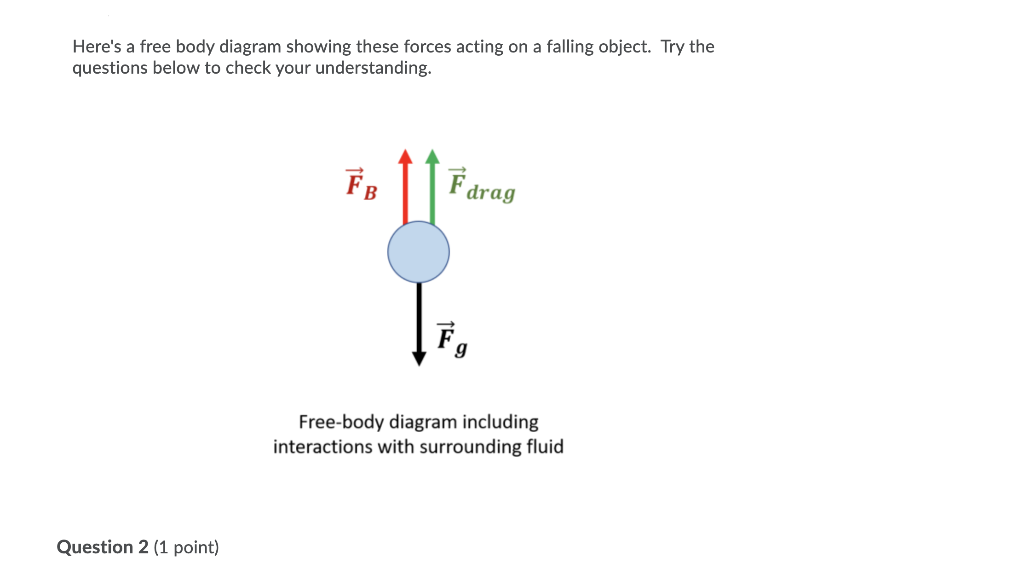

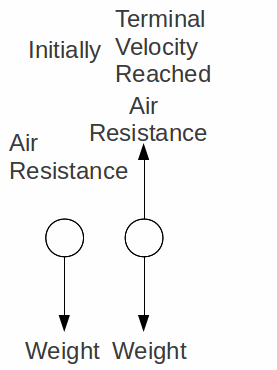
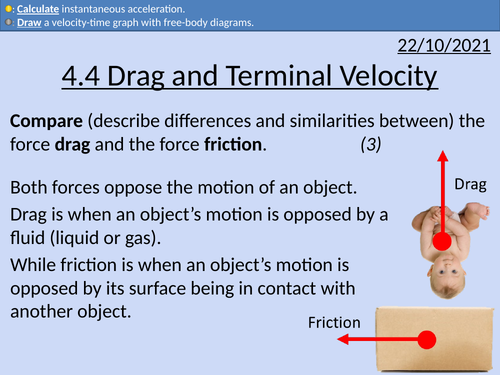


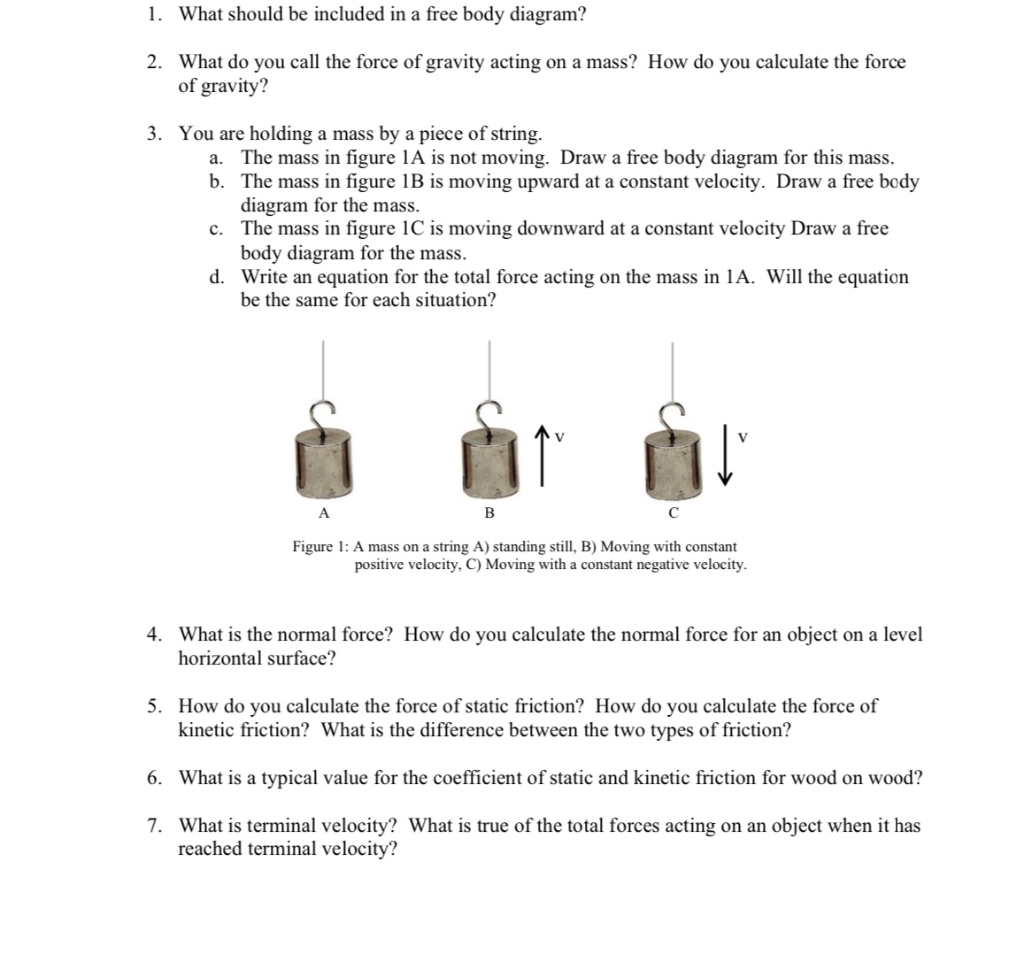

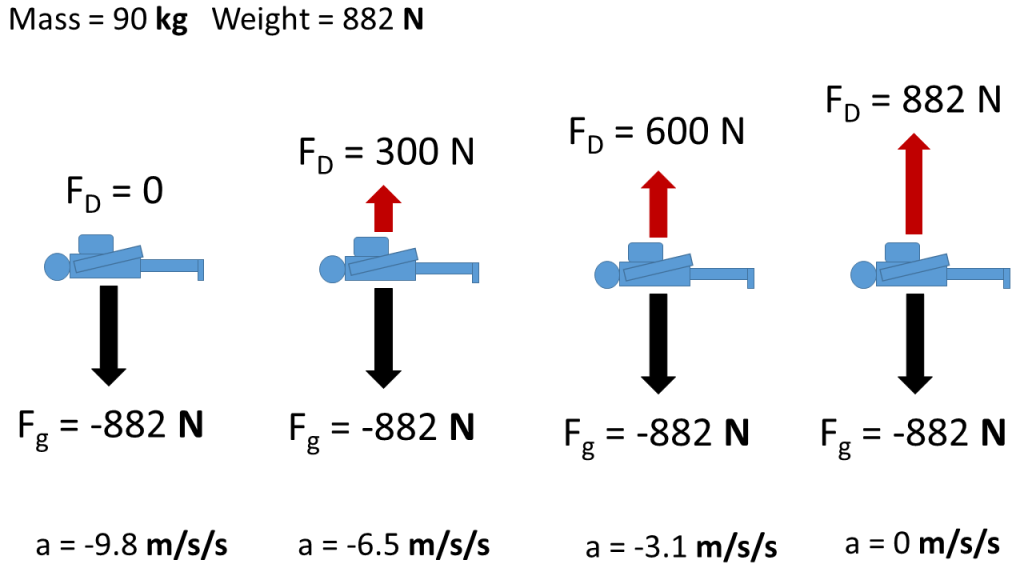

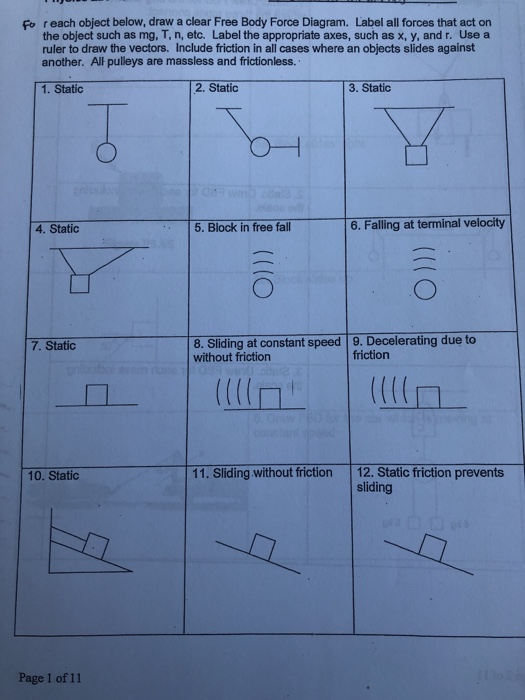

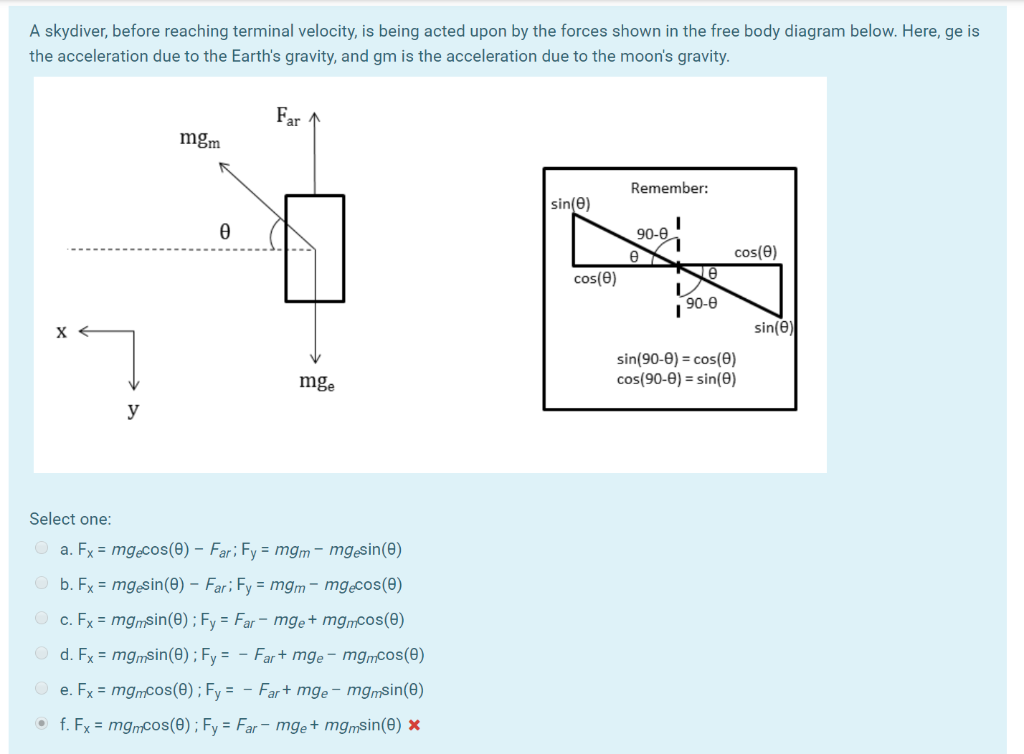


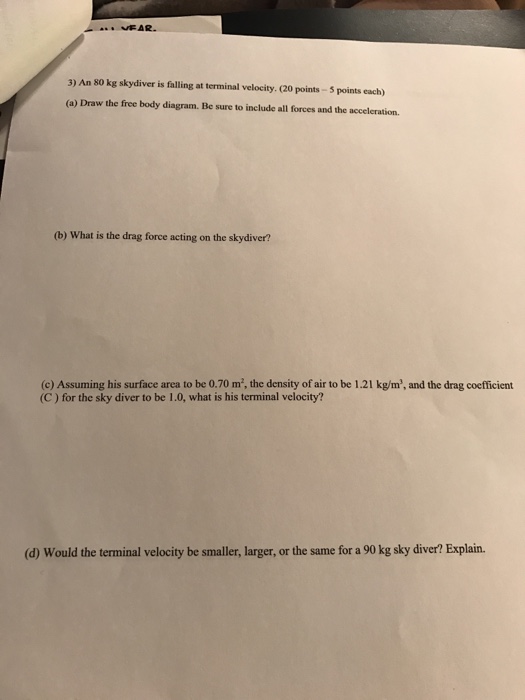


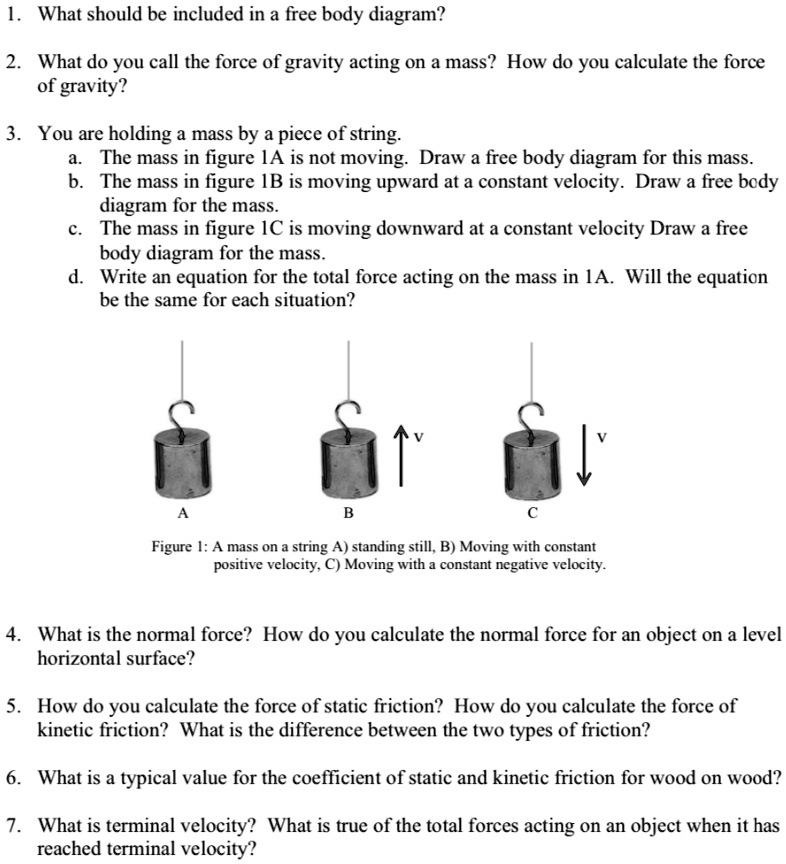

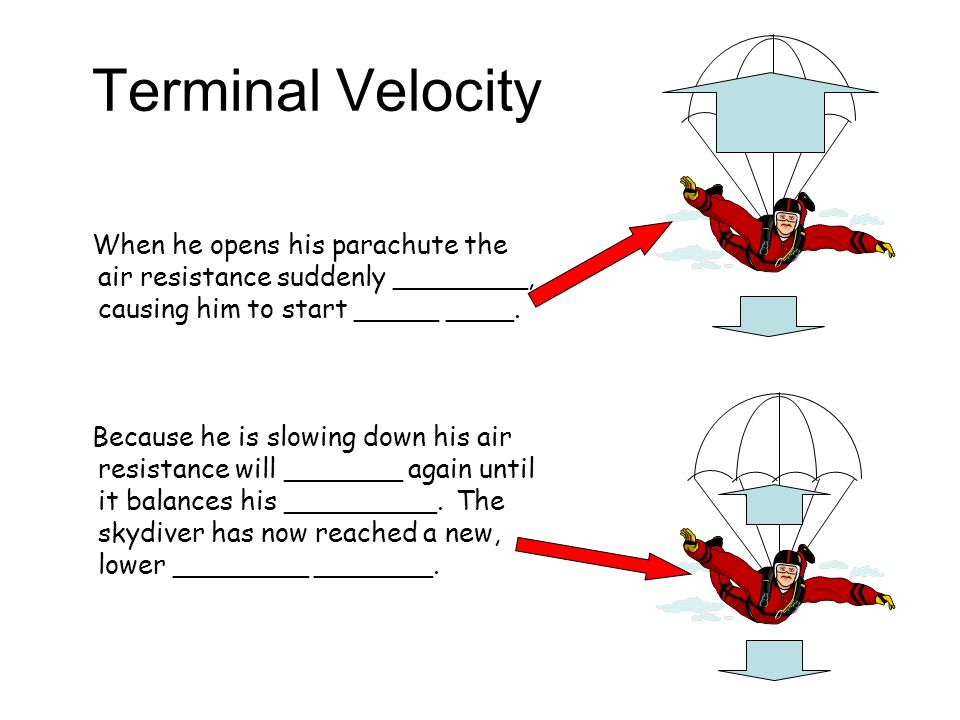








Comments
Post a Comment